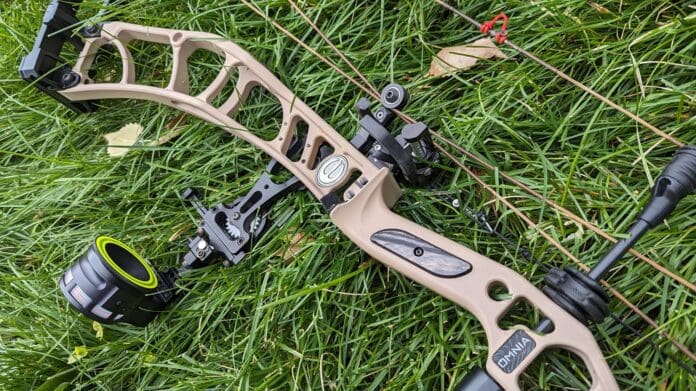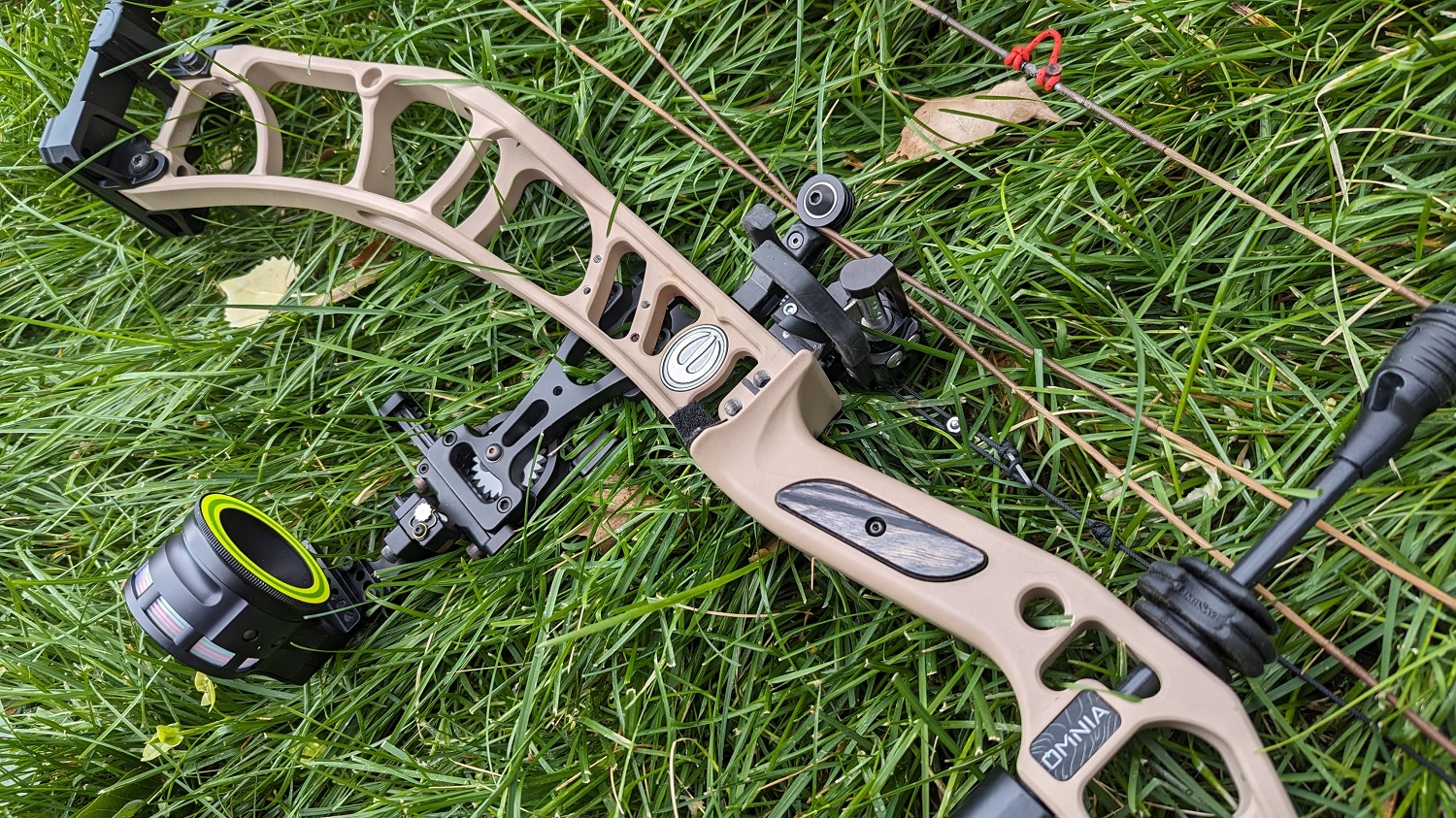
Elite Archery’s fall of 2022 brought the claim of “shootability just got faster” with the introduction of their newest aluminum riser bow, the Elite Omnia. While the Elite bows I have shot in the past have felt just fine, and Elite’s SET Technology makes a ton of sense to me as someone who likes to fine-tune while at the range, I have never been compelled to change and see no gain in velocity. Once I learned of the Omnia’s new SP cam and V2 Micro Mod system that provide an infinite range of draw length and let-off customization, an endless bounty of tinkering fun, I headed over to Rocky Mountain Specialty Gear to give Elite’s Shootability Challenge a try. I was giddy with the smooth draw cycle, and the Omnia’s 347fps IBO rating was no joke, so I ordered one up in Mountain Tan.

Why the Omnia?
In talking with Elite’s Blake Kidder about why the Omnia isn’t “just another speed bow,” he emphasized that their team of engineers focused on eliminating the common complaints associated with speed. Terrible draw cycles, short let-off valleys, and designs unforgiving of form hiccups were targeted for elimination. Kidder explained that the Omnia wasn’t just a change of one component slapped on archaic designs, it is a comprehensive improvement from riser and limb geometry to cam efficiency. Every attribute of the design carried the priority of precisely delivering the arrow to the point of aim, rather than seeking speed to the detriment of accuracy. Lots of hype! My goal with the Omnia became to compare accuracy against a bow that most would call a hybrid hunting/target bow, my Bowtech Reckoning. Kidder doubled down saying that he thought the Omnia to be top of class for a short draw and lower draw weight archer, so we ordered one for my wife, Cindy, in Sienna Brown to compare to her Bowtech Eva Shockey. Our Omnias showed up at Rocky Mountain Specialty Gear a few weeks later.
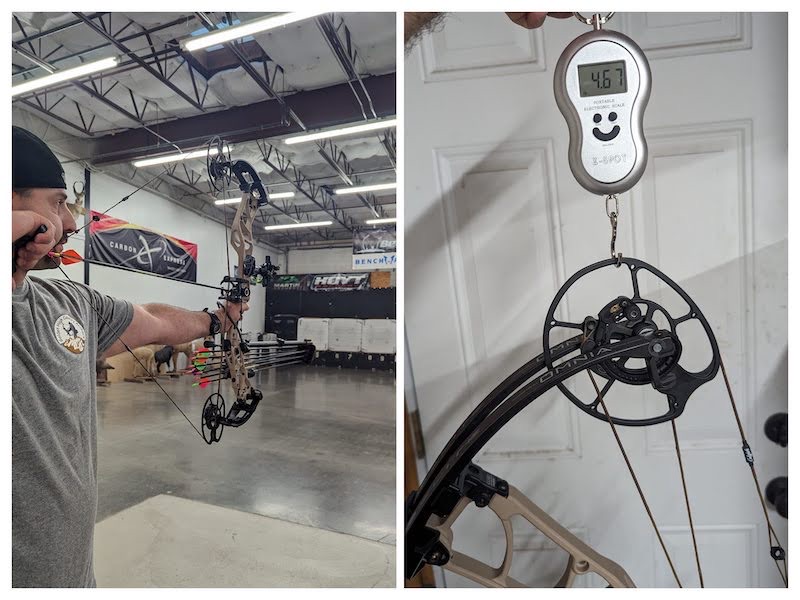
SP Cam and V2 Micro Mods
The Omnia’s SP cam is a rotating module design with (23) ¼” increments marked on each cam in whole number increments from 1 to 12. The SP cam itself has a little viewing window that shows the module position number on one side, and on the other side there is a hash mark on the SP cam that aligns with numbered hash marks on the rotating module. Elite also offers a “smooth” rotating module (more on this later) that is silver and an additional purchase, while the “performance” module that comes standard with the Omnia is black. I found the numbers and hash marks on the black “performance” module to be very difficult to read. We also found the two T15 screws holding the rotating “smooth” or “performance” rotating module to the SP Cam to come loose easily and need some fully cured thread adhesive.
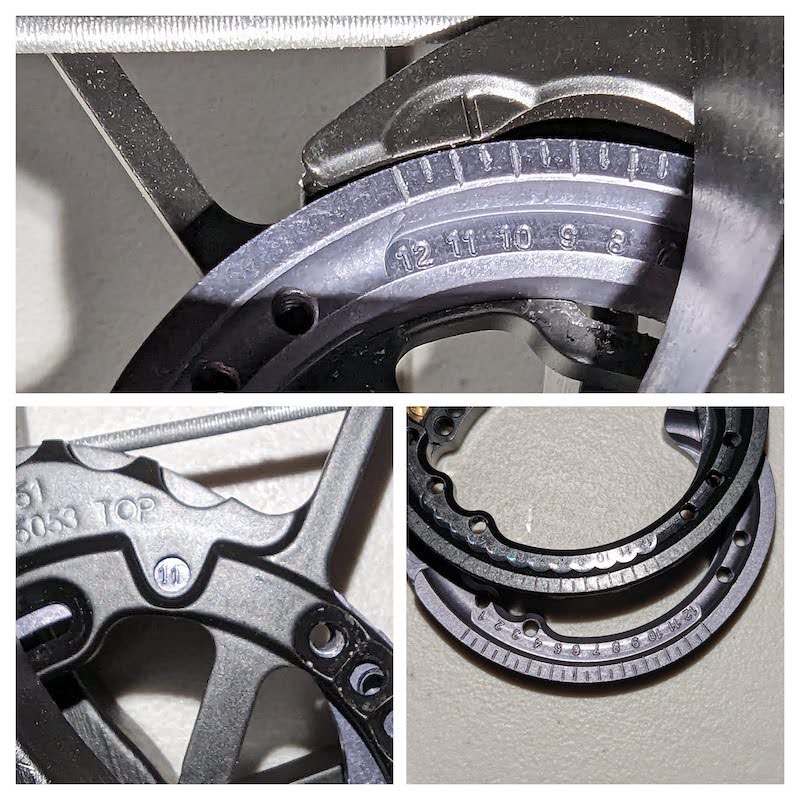
Within that rotating module is the V2 Micro Mod, a sliding module that infinitely adjusts let-off from approximately 90% to 70% and draw length over about a 1” range. The V2 Micro Mod can be set up as either a cable or limb stop. Hash marks on the V2 Micro Mod are present, but not labeled and there are also multiple threaded holes for the limb stop. For the sake of me and you being on the same page, I have them labeled below for how I will be referring to them.
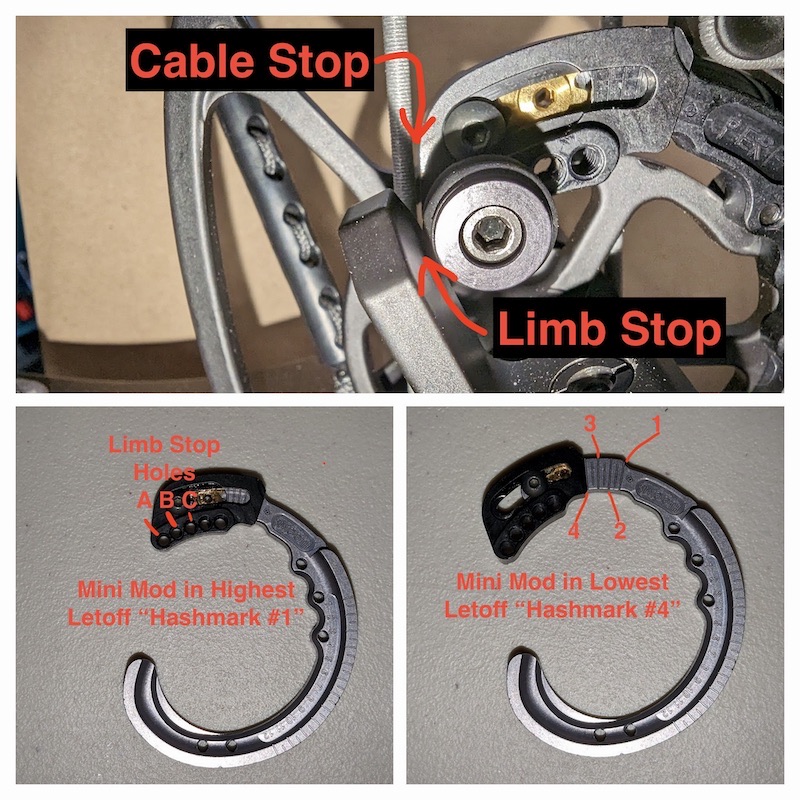
The micro adjustment of let-off and draw length with the V2 Micro Mod are directly tied to each other. Placing the Micro Mod at the 1 hash mark allows the SP Cam to rotate the most, achieving the highest percentage of let-off and longest draw length possible for that particular ¼” increment module position.
Moving the Micro Mod towards the 4 hash stops the draw sooner resulting in a relatively lower let-off percentage and shorter draw length. Both scenarios are shown in the photo above. To adjust the Micro Mod, a small hex bolt is loosened, and a brass cog-gear wheel within is turned with a hex wrench to slide it back and forth.
On both sets of the “smooth” modules Elite sent, the brass gear rattled and this problem was solved with some air cure thread adhesive to gum up the tolerances. Ultimately, the V2 Micro Mod allows the archer to satisfy their exact draw length, let-off, and back wall feel preferences.
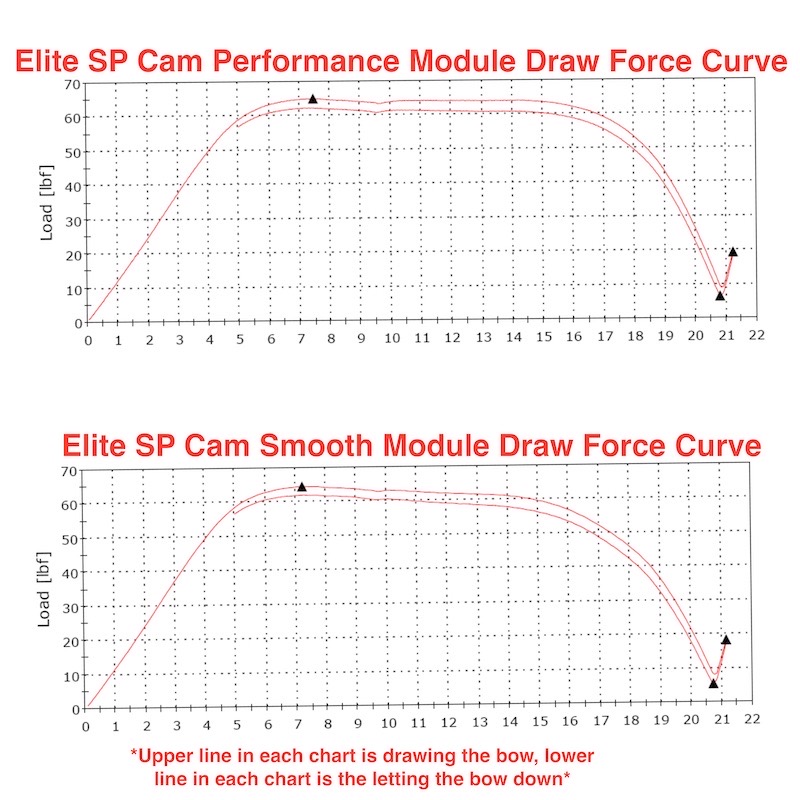
Performance and Smooth Draw Choices
Cindy noticed a drastic difference in between the “smooth” and “performance” modules at her 25.5” draw length. So much so, that while she struggled drawing 57lbs on “performance”, she could handily draw 61lbs on “smooth”.
Velocity testing (chart down below) proved a very linear 4fps difference between “performance” and “smooth” module choices. She ended up with a 2-3fps faster arrow shooting “smooth” modules at a 57lb draw weight, than “performance” at 53lbs.
At my 30.25” draw length, I could not tell the difference between “smooth” and “performance”. However, while gathering velocity data (below) at shorter draw lengths, I did perceive a difference in the draw cycle. It should be noted though, that the SP Cam provides a smooth draw that is drastically better than my Reckoning, and I think bests most current bows at my draw length.
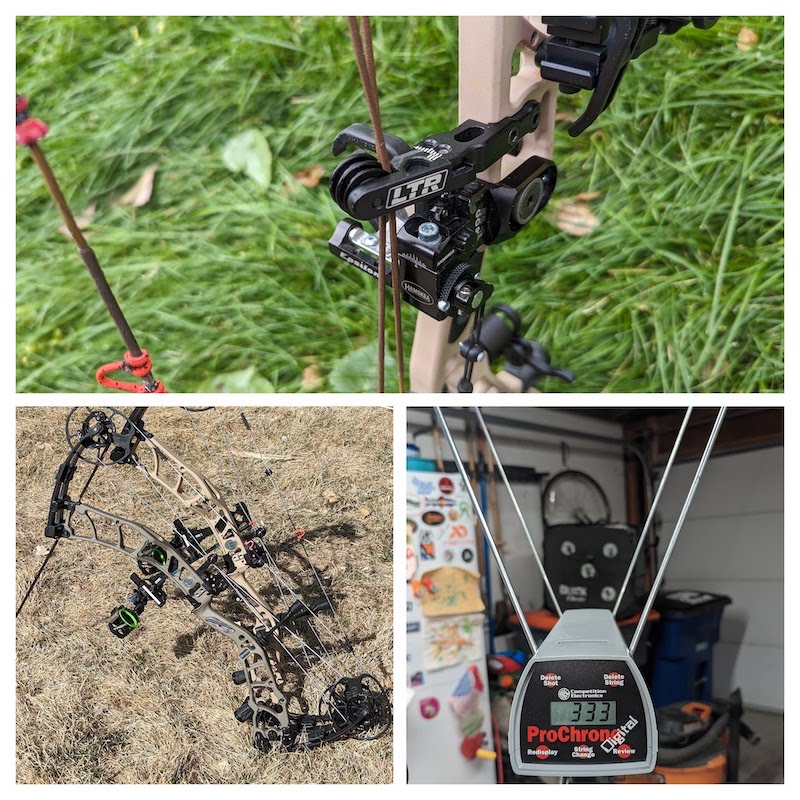
Precise Tuning WITHOUT a Bow Press
Aside from the adjustability of the SP Cam and the V2 Micro Mod, the Omnia offers bow-press-free micro tuning (yippie!) via the SET system (Simplified Exact Tuning) and the LTR cable guide (Linear Tuning Roller).
The LTR (shown above) moves the cable guard left and right to fine-tune fletching clearance and cable load. If an archer needed to make the tiniest of tuning adjustments, while not ideal, they could move the LTR. For example (RH archer), a right paper tear can be eased by moving the LTR right which increases cable load.
The SET system tilts the limb pocket and eliminates the need to shim cams or twist Y yokes. It is ridiculously easy! A locking bolt on the belly of the riser at each limb pocket is loosened, and on the side of the riser SET is adjusted with another bolt. Next to the SET adjusting bolt is a picture showing which way to turn it based on the tuning need. For reference, both Eras we received, and later on an Elite Era, all had a SET “factory zero” of ¾ turn counter-clockwise from being fully tightened clockwise.
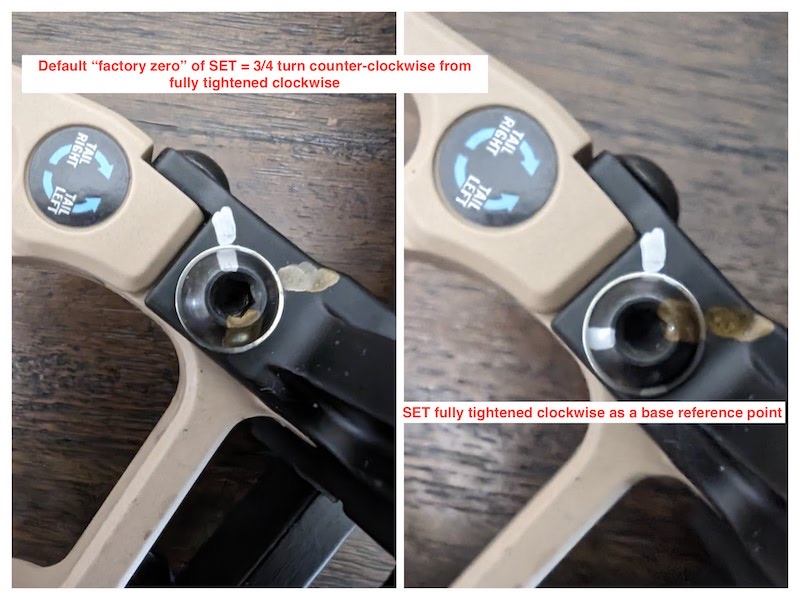
Hamskea Epsilon rests were set up with a centershot of 13/16” to 7”8” and nock height was set with the bottom of the arrow barely below splitting the berger hole.
Cindy used both Gold Tip Pierce and Victory RIP XV in a 400 spine for her 57lb draw weight, and I used Gold Tip Pierce in a 250 spine for my 70lb draw weight. Tuning was easy for both of us, and literally took a few shots.
Below shows my 70lb Omnia “factory zero” SET position (two silver sharpie marks lined up) 250 spine Pierce fletched and bare shafts shot through paper. A left tear = turn SET counter clockwise as the picture on the bow shows. Resulting good paper tears proofed by the same point of impact for fletched and bare shafts at 40yds. Cindy’s tuning went just the same, and neither of us needed further adjustment to tune both Cutthroat 2-Blade or Cutthroat 3-Blade broadheads.
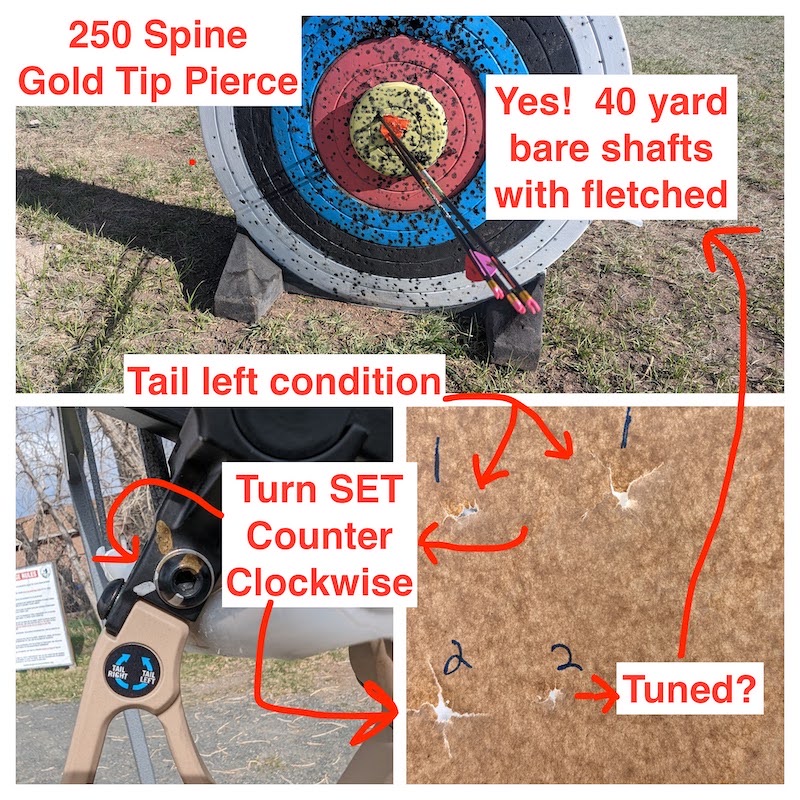
That tuning is all well and good as those arrows are spined properly for the draw weights. I wanted to see how difficult it would be to tune an improperly spined arrow. I picked up some 380 spine Victory Vtac 23 arrows and as expected, they showed a right tear. Following the picture on the side of the Omnia, I turned SET clockwise past the “factory zero” and was tuned up in 7 shots.
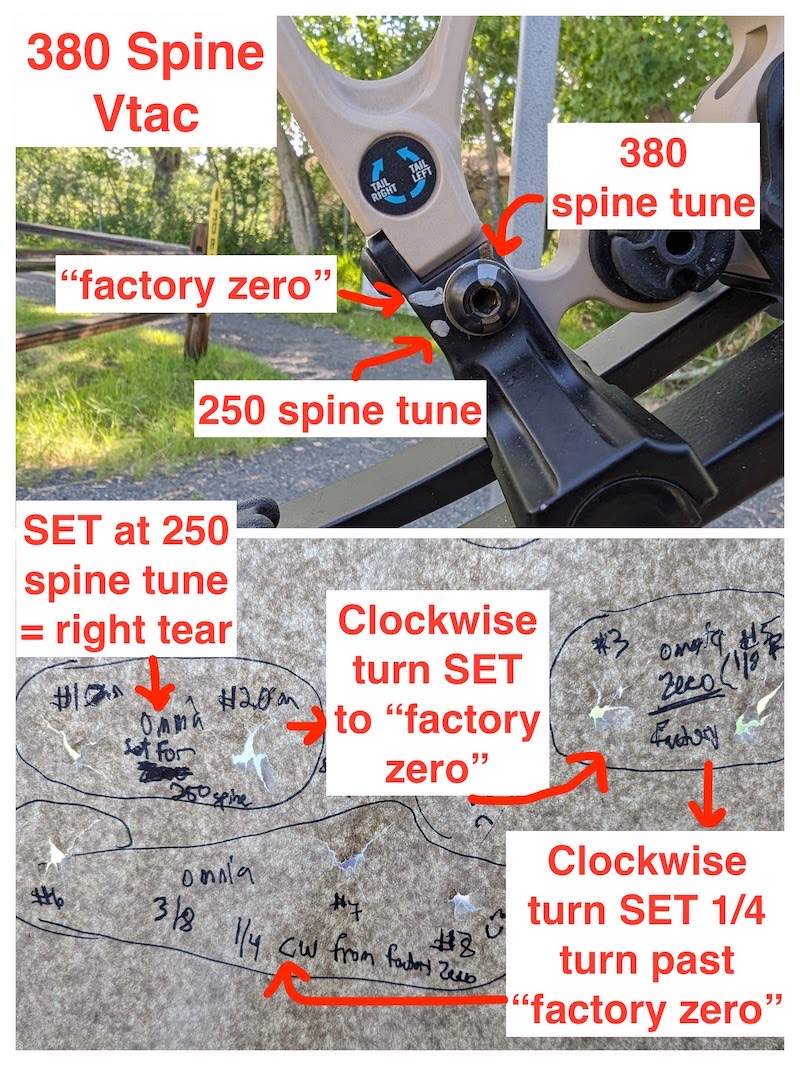
That Thing About Speed WITH Accuracy
So how did we shoot? My results were a scoring INCREASE of about 2-3% for both indoor spot league and outdoor 3D league as well as about 14fps. Both Cindy and I used CBE 5-Pin Trek Pro sights, Hamskea Raptor Peeps, 8-arrow Quivalyzer for me, and 5-arrow Quivalyzer for her.
Cindy turned up a 10-12% scoring INCREASE and a whopping 27fps increase. While the Omnia does have both high and low front stabilizer mount inserts, as well as one in the back, neither of us wanted anything more than the included 2” stabilizer and Quivalyzer. The limb dampeners and string stop also did their job superbly and shock or vibration was never an issue.
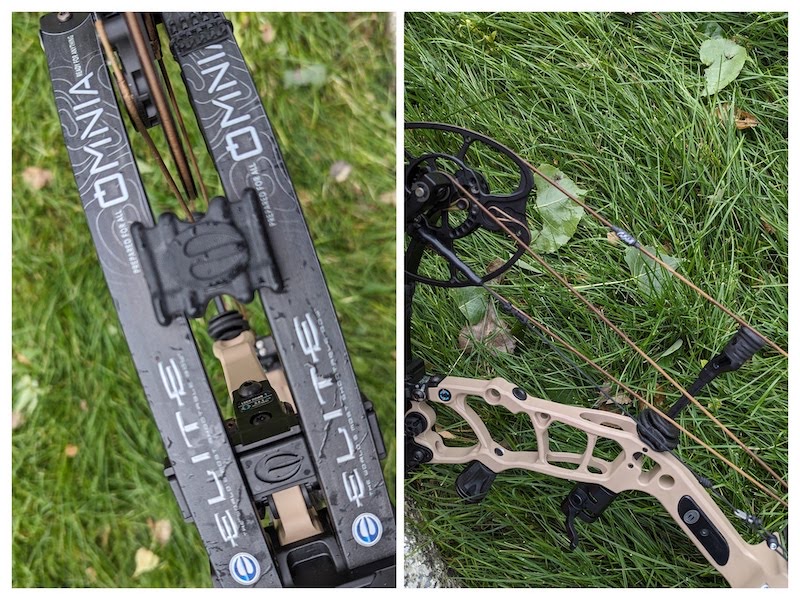
…But, It’s Finicky, Right?
I greatly appreciated the side plate grip that is a low wrist and has just a tiny little bit of taper on the top back. Shooting with different weight and texture gloves proved to not be an issue and my accuracy didn’t drop one bit. Even though the Omnia is a speed bow, being layered up for 20 degree temps and wet snow didn’t alter arrow flight, point of impact, or tune. This was the day that I really fell in love with this bow and knew the engineers at Elite had overachieved. In the past, I always had some changes in point of impact or flight with gloves or layers on, but not with the Omnia.

The (triple digit) Cold Bow Challenge
For the past few years of Rokslide’s Cold Bow Challenge, I have shot between 60 and 65 yards choosing a Maximum Effective Range that required a tricky hold over of my 60 yard pin. With the increased speed of the Omnia, that shot wasn’t very tricky, and beyond 65 yards, I would always choose to roll/slide my sight. I decided to shoot at 100 yards and the Omnia is more than capable in steadiness and forgiveness to practice on demand at this distance.
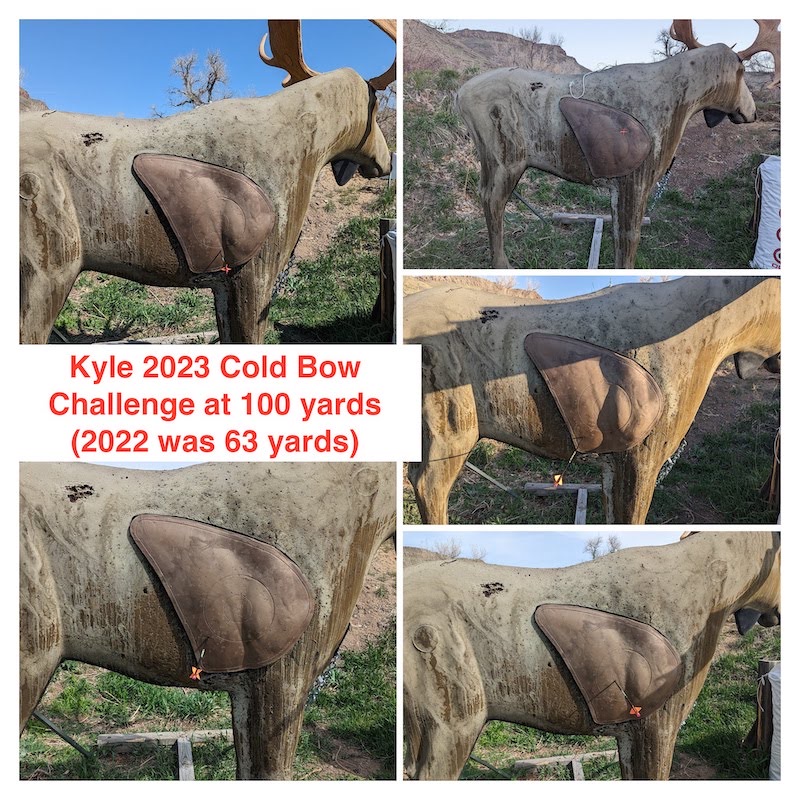
What Does a Woman Think?
I asked Cindy for her thoughts.
“The first thing I noticed about the Omnia was the smooth draw. I had heard that fast bows were hard to draw and I expected a few weeks of wrestling through it until I adjusted, but the draw was smooth and comfortable. So, moving to the Omnia from my previous set-up allowed a draw weight increase. Additionally, my shots seemed to be more dialed in, meaning there were little misses when I knew I executed my shot poorly and I felt magical when I executed perfectly. The smooth draw, HUGE increase in velocity, and the limb stop’s firm back wall, all helped me improve the consistency of my arrow placement.
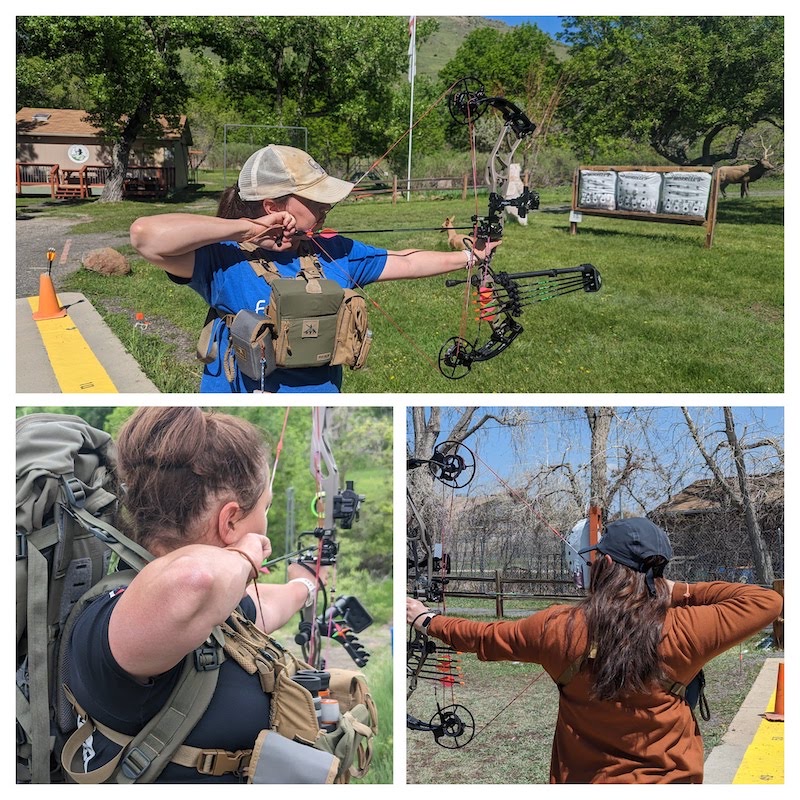
I also appreciate the ease of changing the modules between performance and comfort, as well as the ease in adjusting the draw weight. I was able to go in the garage a few times a day and dial in the draw length and cycle easily with the Micro Mod ON MY OWN because it was simple to understand. Practice with this bow has improved my confidence in accuracy as well as making the longer shots. I shot the Cold Bow Challenge at 60 yards, and did great! In the past I only felt comfortable at 45 yards because of how much slower my old bow was, I didn’t have much more sight range and the arrow seemed sporadic. Overall, the Omnia is a top performer and will be one that I stick with for a while.” -Cindy Sandusky-
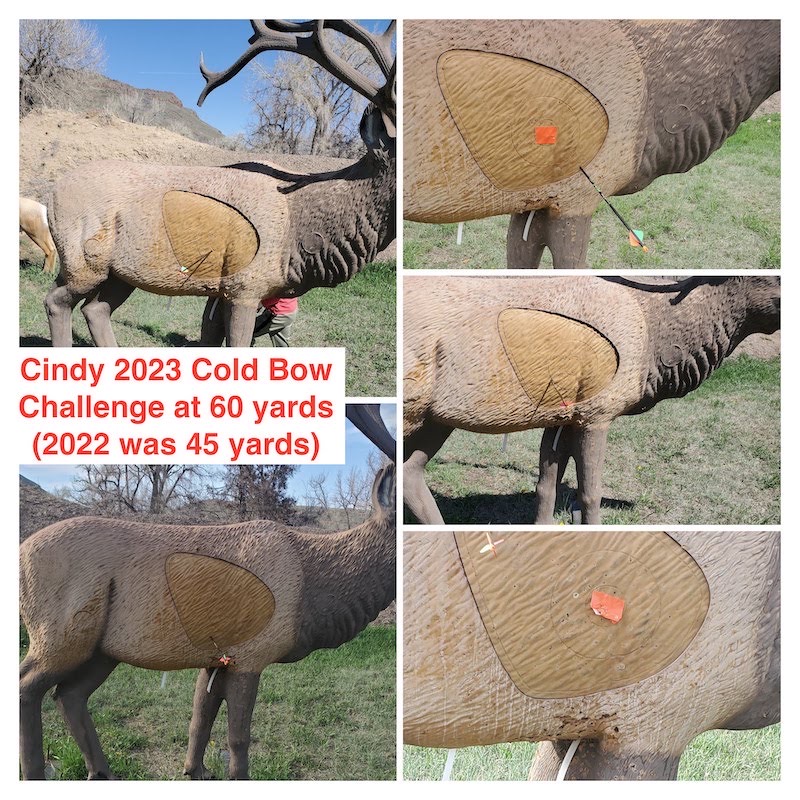
Overall, Cindy and I both went four arrows out of five into the 10” vital—pretty happy with this.
Here are the Velocity Numbers You Came For
It’s a speed bow right? Both “smooth” and “performance” modules, various draw weights, draw lengths, and arrow weights were shot through a chronograph. I initially thought that adjusting the V2 Micro Mod throughout its range would have a big effect on velocity because it is changing the power stroke and let-off percentage, but the variance was not more than 2fps. Because of that, the below chart is with the V2 Micro Mod in the middle of its adjustment range (~2.5 hash mark), and I used the cable stop.

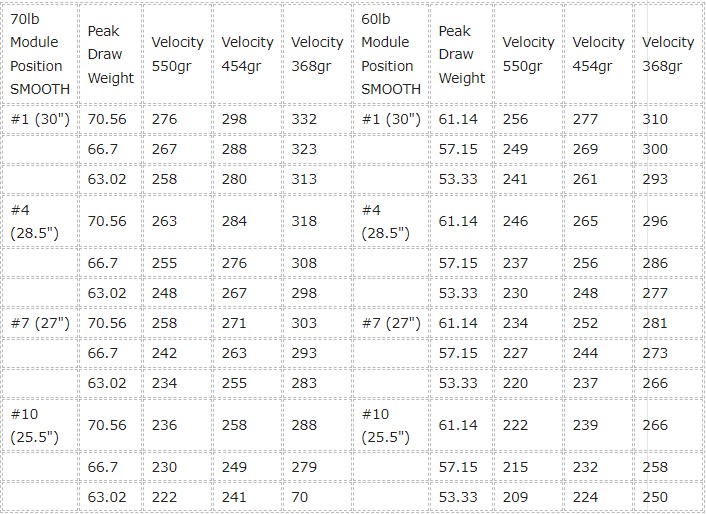 *All velocity is taken with the cable stop adjusted to the midway point (~2.5 hash).
*All velocity is taken with the cable stop adjusted to the midway point (~2.5 hash).
The results were boringly predictable and linear. ~4fps difference between “smooth” and performance”, the various online velocity calculators were all pretty close, and there wasn’t a huge spike or drop off at a certain draw length like some bows tend to exhibit. I included some other bows for comparison and think it is interesting that a 60lb Omnia can achieve about the same velocity as an average IBO (~330-335fps) rated bow.
| Bow | Specs | 550gr | Bow | Specs | 550gr |
| Prime Inline 5 | Prime Inline 5 28.5″ setting (28 5/8″ actual) 79.75lb | 275fps | Omnia (Performance) | #1.5 Module at limbstop B micro mod hash 1 (30.375″ actual DL) with Catfish Customs strings 70.7lb | 283fps |
| Hoyt Rx7 | 27.5″ 74.8lbs | 264 | Omnia (Smooth) | #1.5 Module at limbstop B micro mod hash 1 (30.375″ actual DL) with FACTORY strings 70.56lb | 277 |
| Elite Era (Smooth) | #3.5 Module at limbstop B (30.25″ actual DL) with Catfish Customs strings 70.42lb | 262 | Omnia (Performance) | #1 Module at limbstop B micro mod hash 2 (30.375″ actual DL) with Catfish Customs strings 70.7lb | 285 |
| Elite Era (Performance) | #3.5 Module at limbstop B (30.25″ actual DL) with Catfish Customs strings 70.42lb | 265 | Omnia (Smooth) | #1 Module at limbstop B micro mod hash 2 (30.375″ actual DL) with FACTORY strings 70.56lb | 280 |
| Elite Era (Smooth) | #1 Module at limbstop A with micro mod at mark 3 (30.375″ actual draw length) | 270 | Bowtech Reckoning | 70.56 30.5″ Performance | 269 |
Something that was SUPER intriguing was that velocity for the Omnia seemed to follow what mod position the SP Cam was in. With the adjustability of the V2 Micro Mods, an archer COULD set the SP Cam at a longer position, but then slide the Micro Mod to shorten the draw length and shoot with the least amount of let off. The chart above shows this example with the Elite Era (highlighted in red) where I gained 8fps. My 30.25” draw length maxed out the SP Cam on the Omnia, so I was only able to realize this once the Era arrived. The concept could be implemented with the Omnia by an archer whose draw length is shorter than mine.
…Let’s Nerd-Out On Charts
I have talked a lot about the adjustability of the SP Cam and the V2 Micro Mods. In my eyes, it wouldn’t make complete sense without showing the resulting ACTUAL draw length at each module position when the V2 Micro Mods are adjusted. I measured both the “smooth” and the “performance” modules, and found no difference between the two, and also there was no difference between my 70lb bow and Cindy’s 60lb bow.
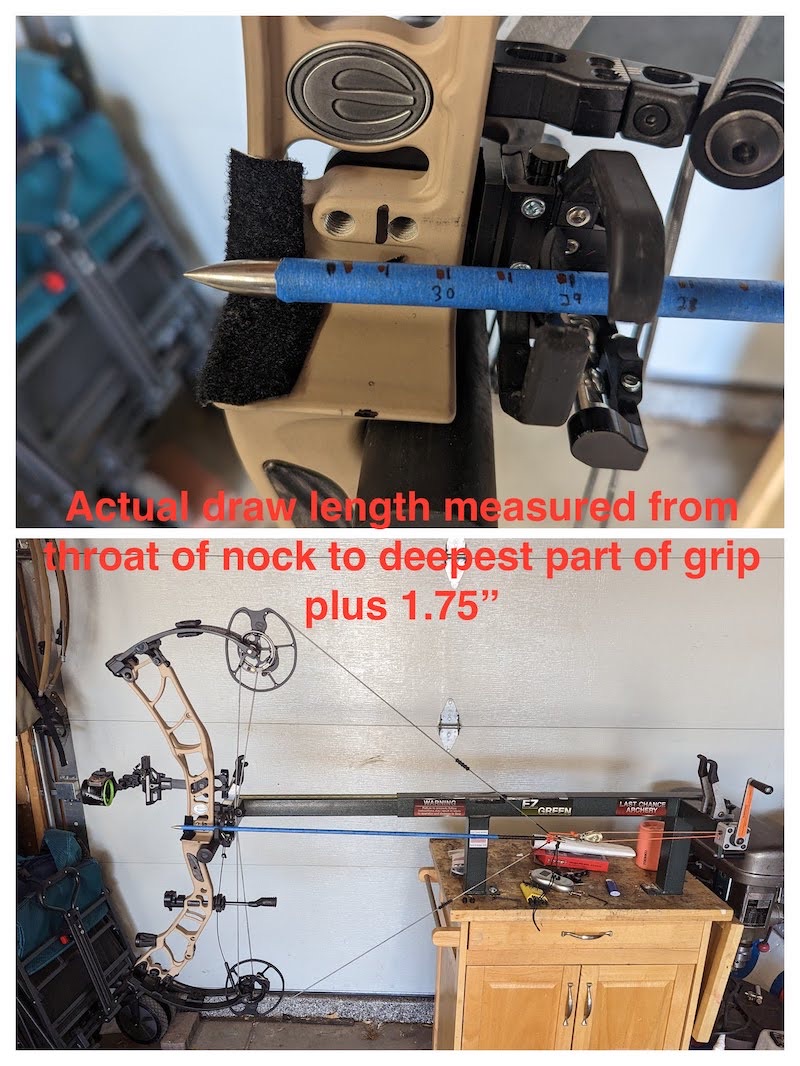
| Mod Position | Stated Draw Length “at 80% let-off” | Cable Stop Hash 4 (lowest let-off) | Cable Stop Hash 3 | Cable Stop Hash 2 | Cable Stop Hash 1 (highest let-off) | Limb stop hole A* | Limb stop hole B* | Limb stop hole C* |
| 1 | 30 | 30 | 30.25 | 30.4375 | 30.625 | 30 | 30.625 | n/a |
| 1.5 | 29.75 | 29.75 | 30 | 30.125 | 30.375 | 29.75 | 30.375 | n/a |
| 2 | 29.5 | 29.5 | 29.6875 | 29.875 | 30.125 | 29.4375 | 30 | n/a |
| 2.5 | 29.25 | 29.25 | 29.4375 | 29.625 | 29.875 | 29.125 | 29.75 | n/a |
| 3 | 29 | 29 | 29.1875 | 29.4375 | 29.5625 | 28.8125 | 29.5 | n/a |
| 3.5 | 28.75 | 28.75 | 29 | 29.125 | 29.375 | 28.5 | 29.25 | n/a |
| 4 | 28.5 | 28.5 | 28.6875 | 28.875 | 29.125 | 28.25 | 29 | n/a |
| 4.5 | 28.25 | 28.25 | 28.4375 | 28.625 | 28.875 | 27.9375 | 28.625 | n/a |
| 5 | 28 | 28 | 28.1875 | 28.375 | 28.625 | 27.625 | 28.375 | n/a |
| 5.5 | 27.75 | 27.75 | 27.9375 | 28.125 | 28.375 | 27.375 | 28 | n/a |
| 6 | 27.5 | 27.5 | 27.6875 | 27.875 | 28.125 | 27.125 | 27.75 | n/a |
| 6.5 | 27.25 | 27.25 | 27.5 | 27.75 | 27.875 | 26.625 | 27.5 | n/a |
| 7 | 27 | 27 | 27.25 | 27.5 | 27.625 | 26.4375 | 27.25 | n/a |
| 7.5 | 26.75 | 26.75 | 26.875 | 27.1875 | 27.375 | 25.8125 | 26.75 | 27.375 |
| 8 | 26.5 | 26.5 | 26.5625 | 26.875 | 27.125 | 25.625 | 26.375 | 27.125 |
| 8.5 | 26.25 | 26.25 | 26.5 | 26.625 | 26.875 | 25.125 | 26 | 26.75 |
| 9 | 26 | 25.75 | 26 | 26.25 | 26.625 | 24.375 | 25.625 | 26.125 |
| 9.5 | 25.75 | 25.5 | 25.75 | 26.125 | 26.25 | 24.25 | 25.125 | 26 |
| 10 | 25.5 | 25.375 | 25.5 | 25.75 | 26 | 24.125 | 24.75 | 25.875 |
| 10.5 | 25.25 | 25 | 25.25 | 25.5 | 25.75 | 23.375 | 24.375 | 25.5 |
| 11 | 25 | 24.625 | 24.875 | 25.25 | 25.5 | 23.125 | 24.25 | 25.125 |
| 11.5 | 24.75 | 24.375 | 24.75 | 25 | 25.125 | 22.5 | 23.625 | 24.625 |
| 12 | 24.5 | 24.25 | 24.625 | 24.875 | 25 | 22.375 | 23.25 | 24.25 |
*All limb stop measurements taken with Micro Mod set at highest let-off hash mark (hashmark #1)
Seriously, Go Shoot One
Overall, Elite’s Omnia blew our expectations away. Both Cindy and I picked up velocity and improved our objective scores. I don’t think a whole lot of subjective comments should go into these reviews because everyone is different, but I genuinely love this bow. I think it is a phenomenal choice for someone who wants to shoot a lighter draw weight or is hampered by a shorter draw length. For someone like me who doesn’t NEED more speed due to having a longer than average draw length, it proved to be a huge confidence booster with its forgiveness and accuracy. It is a little over 4.5 lbs as a bare bow, but I think that helps with the float stability and promotes accuracy.
The MSRP at $1199 is outstanding. We saw zero issues with the factory Winner’s Choice strings before switching to Catfish Customs. Riser finish has stood up to my intentional carelessness. While I think it is nearly impossible to buy a bad bow in 2023, I think the Elite Omnia is in the mix for the best around.
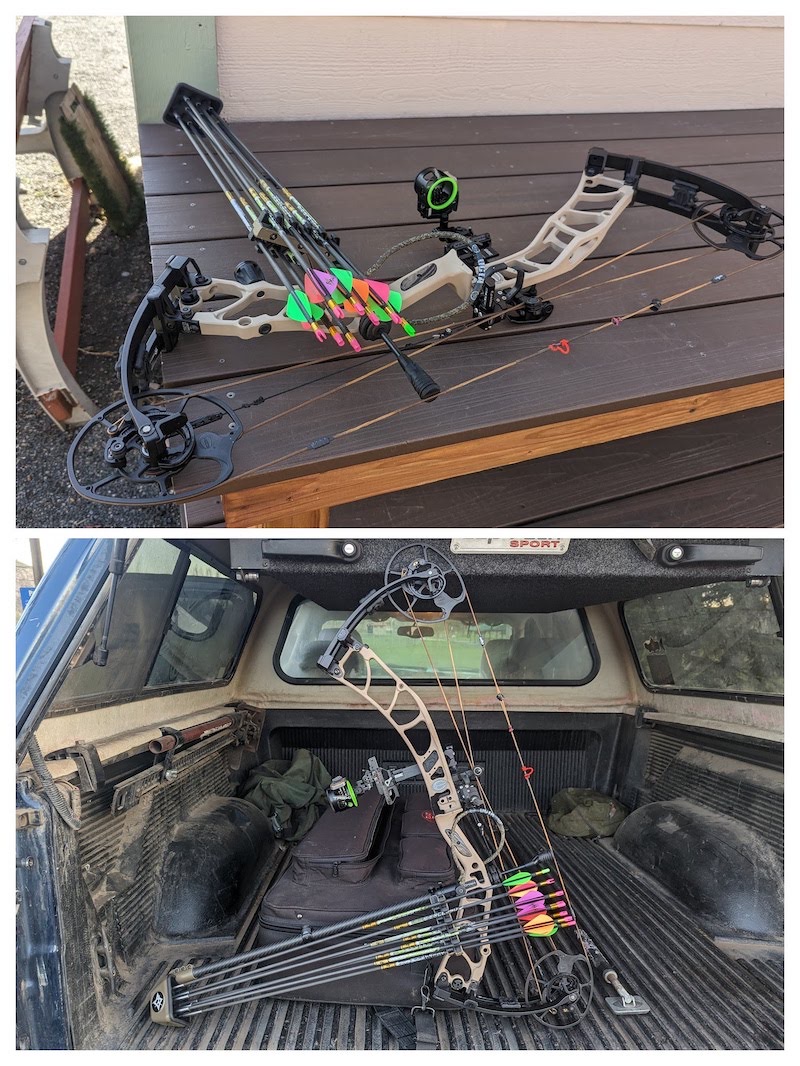
If you are on Colorado’s Front Range, hit up Rocky Mountain Specialty Gear to test drive an Omnia. Otherwise, use Elite Archery’s Dealer Locator.
Ask Kyle and Cindy questions here.














